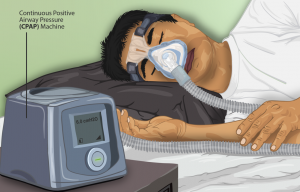Continuous Positive Airway Pressure (CPAP)
When thinking of a mask interface and pressure delivered, most people will think about CPAP and CPAP machines. CPAP is usually used for home patients that have obstructive sleep apnea. Though still pressure-applied, CPAP is not considered ventilation for a one main reason: Continuous Positive Airway Pressure (CPAP)—the name says it all. This mode literally applies one constant (or continuous) pressure through the circuit and mask interface to be delivered to the patient. Though CPAP is discussed in this chapter as a non-invasive therapy, it is not a method of non-invasive ventilation (NIV). Ventilation at its core refers to the clearance of carbon dioxide. As we have discussed, CO2 clearance happens during exhalation, and if you want to clear more CO2, you need to take a bigger breath in and, most importantly, out. In order to help the lungs inflate larger, a higher pressure must be applied during inspiration. Since CPAP is one constant pressure, CPAP does not change the pressure applied to help augment tidal volumes and does not contribute to the clearance of CO2.

The main benefit of CPAP stems from the patient breathing spontaneously in and out against the set pressure. Exhaling against positive pressure, produces a back pressure that increases the air left in the lungs at the end of a breath. This can help open collapsed airways or alveoli and is often referred to as a splinting effect.
Object Lesson

This splinting effect can be useful for specific lungs issues. It is beneficial in recruiting collapsed alveoli. Involving more alveoli in air exchange will improve ventilation. Another benefit of this “splinting effect” is seen with patients who have symptoms of obstructive sleep apnea. CPAP stops the soft tissue of their nasopharyngeal region of collapsing and closing off. In a way, CPAP is similar to PEEP but just called something different because we are not in an invasive ventilation mode.
CPAP is periodically used for patients that need some help with recruiting or splinting open their airways, but in critical care and hospital settings, NIV or BiPAP is usually preferred because it allows the practitioner more control over oxygenation and ventilation. Therefore, we will focus on NIV instead of CPAP, as it is used to a much larger degree in critical care medicine.
Key Concept
Media Attributions
- CPAP_machine © https://www.myupchar.com/en is licensed under a CC BY-SA (Attribution ShareAlike) license
- pexels-monstera-7352958 © Monstera is licensed under a CC BY (Attribution) license

